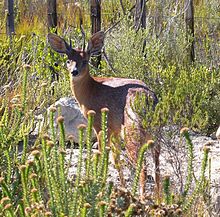This article includes a list of general references, but it lacks sufficient corresponding inline citations. (February 2022) |
The Cape or southern grysbok (Raphicerus melanotis) is a small antelope that is endemic to the Western Cape region of South Africa between Albany and the Cederberg mountains.
| Cape grysbok | |
|---|---|

| |
| A ram at De Hoop, Western Cape | |
| Scientific classification | |
| Domain: | Eukaryota |
| Kingdom: | Animalia |
| Phylum: | Chordata |
| Class: | Mammalia |
| Order: | Artiodactyla |
| Family: | Bovidae |
| Subfamily: | Antilopinae |
| Genus: | Raphicerus |
| Species: | R. melanotis
|
| Binomial name | |
| Raphicerus melanotis (Thunberg, 1811)
| |

| |
| range | |
Description
editIt has a rough, reddish sandy coat flecked in white. The head, neck and legs are less flecked and somewhat yellowish, while the inside of the ears, eye-rings, mouth area, throat and underside are white. There is a black "bridge" to the nose and a dark scent gland in front of the eye. It stands only 21" (45–55 cm) at the shoulder and weighs slightly more than 20 pounds (8–12 kg). The short tail of the Cape grysbok measures 4 to 8 cm and is almost invisible. Males have short, sharp and straight horns about 8 cm long, which are smooth. The Cape grysbok can fluff out the fur at its rear end to make itself look bigger.
Habitat
editThe Cape grysbok's native habitat is the "Fynbos biome" (Cape Floristic Region), and it inhabits thick shrubland. It can sometimes be found browsing orchards and vineyards. In the Cape Peninsula the grysbok can be found in urban edges close to human activity. It may also be found in reed beds and along the riverbed of the southern Karoo.
Habits
editThe Cape grysbok is probably territorial as sightings are mostly of individual animals. It is a browser. It can apparently go without drinking water for long periods, gaining most of its requirements from its food. It is primarily nocturnal, though it may be seen during early morning and late evening during the southern winter. Like Sharpe's grysbok they use a communal latrine and mark plants in its vicinity with secretions from their pre-orbital glands. It defends itself by jumping forward toward its target then running away.[2]
Breeding
editLambs are born in the southern summer after a gestation period of about 6 months. They stay hidden and grow fast.
Similar species
editThe similar Sharpe's grysbok (Raphicerus sharpei) can be found in south-eastern Africa. The primary physical difference between the two grysboks is that Sharpe's has a pair of "false hooves" above the fetlocks.
Notes
edit- ^ Palmer, G.; Birss, C.; Kerley, G.; Feely, J.; Peinke, D.; Castley, G. (2017). "Raphicerus melanotis". IUCN Red List of Threatened Species. 2017: e.T19306A50193334. doi:10.2305/IUCN.UK.2017-2.RLTS.T19306A50193334.en. Retrieved 11 November 2021.
- ^ Chris; Stuart, Tilde (2000). A field guide to the tracks and signs of Southern and East African wildlife (3rd ed.). Cape Town: Struik. p. 142. ISBN 1868725588. Retrieved 30 July 2015.[permanent dead link]
References
edit- Kingdon, Jonathan. 1997. The Kingdon Field Guide to African Mammals. Academic Press, San Diego & London. pp. 386–387. (ISBN 0-12-408355-2)
